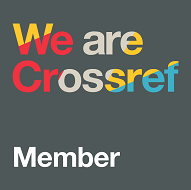Development of Learning Media Based on Google Sites with a Problem-Based Learning Approach to Increase Interest in Learning Data Communication and Computer Networks
Abstract
Full Text:
PDFReferences
M. D. Abdulrahaman et al., “Multimedia tools in the teaching and learning processes: A systematic review,” Heliyon, vol. 6, no. 11. Elsevier, p. e05312, Nov. 01, 2020. doi: 10.1016/j.heliyon.2020.e05312.
E. Perez, S. Manca, R. Fernández-Pascual, and C. Mc Guckin, “A systematic review of social media as a teaching and learning tool in higher education: A theoretical grounding perspective,” Educ. Inf. Technol., vol. 28, no. 9, pp. 11921–11950, Sep. 2023, doi: 10.1007/s10639-023-11647-2.
C. A. Bonfield, M. Salter, A. Longmuir, M. Benson, and C. Adachi, “Transformation or evolution?: Education 4.0, teaching and learning in the digital age,” High. Educ. Pedagog., vol. 5, no. 1, pp. 223–246, Jan. 2020, doi: 10.1080/23752696.2020.1816847.
K. Morris and F. Yeoman, “Teaching Future Journalists the News: The Role of Journalism Educators in the News Literacy Movement,” Journal. Pract., vol. 17, no. 7, pp. 1573–1590, Aug. 2023, doi: 10.1080/17512786.2021.1992599.
Q. H. Tran-Duong, “The effect of media literacy on effective learning outcomes in online learning,” Educ. Inf. Technol., vol. 28, no. 3, pp. 3605–3624, 2023, doi: 10.1007/s10639-022-11313-z.
K. Asfani, H. Elmunsyah, S. Patmanthara, W. Nur Hidayat, H. Suswanto, and H. B. Awang, “Distance Learning Scheme with Remote Desktop Application for Mikrotik Configuration Practice in the Covid-19 Pandemic Era,” in 2022 5th International Conference on Vocational Education and Electrical Engineering: The Future of Electrical Engineering, Informatics, and Educational Technology Through the Freedom of Study in the Post-Pandemic Era, ICVEE 2022 - Proceeding, Institute of Electrical and Electronics Engineers Inc., 2022, pp. 216–220. doi: 10.1109/ICVEE57061.2022.9930444.
Y. L. Lai and C. I. Jen, “Using Google Sites to promote 7th graders’ information literacy, reading comprehension, and information Technology through inquiry-based learning in Taiwan,” in Communications in Computer and Information Science, Springer Verlag, 2015, pp. 317–327. doi: 10.1007/978-3-319-28197-1_33.
B. Gan, T. Menkhoff, and R. Smith, “Enhancing students’ learning process through interactive digital media: New opportunities for collaborative learning,” Comput. Human Behav., vol. 51, pp. 652–663, Oct. 2015, doi: 10.1016/j.chb.2014.12.048.
H. Halimatusyadiah and D. Disman, “The Benefits of Interactive Media Websites Through Google Sites on Learning Outcomes of Elementary School Students,” J. Ling. Idea, vol. 14, no. 1, p. 92, Jun. 2023, doi: 10.20884/1.jli.2023.14.1.8305.
I. G. Smarandache, L. P. Maricutoiu, M. D. Ilie, D. E. Iancu, and V. Mladenovici, “Students’ approach to learning: evidence regarding the importance of the interest-to-effort ratio,” High. Educ. Res. Dev., vol. 41, no. 2, pp. 546–561, Feb. 2022, doi: 10.1080/07294360.2020.1865283.
A. S. A. Ghani, A. F. A. Rahim, M. S. B. Yusoff, and S. N. H. Hadie, “Effective Learning Behavior in Problem-Based Learning: a Scoping Review,” Medical Science Educator, vol. 31, no. 3. Springer, pp. 1199–1211, Jun. 01, 2021. doi: 10.1007/s40670-021-01292-0.
L. Wijnia, G. Noordzij, L. R. Arends, R. M. J. P. Rikers, and S. M. M. Loyens, “The Effects of Problem-Based, Project-Based, and Case-Based Learning on Students’ Motivation: a Meta-Analysis,” Educ. Psychol. Rev., vol. 36, no. 1, pp. 1–38, Mar. 2024, doi: 10.1007/S10648-024-09864-3/TABLES/4.
C. C. Wang, “The process of implementing problem-based learning in a teacher education program: an exploratory case study,” Cogent Educ., vol. 8, no. 1, Jan. 2021, doi: 10.1080/2331186X.2021.1996870.
K. Smith et al., “Principles of Problem-Based Learning (PBL) in STEM Education: Using Expert Wisdom and Research to Frame Educational Practice,” Educ. Sci., vol. 12, no. 10, p. 728, Oct. 2022, doi: 10.3390/educsci12100728.
J. M. Harackiewicz, J. L. Smith, and S. J. Priniski, “Interest Matters: The Importance of Promoting Interest in Education,” Policy Insights from Behav. Brain Sci., vol. 3, no. 2, pp. 220–227, Jun. 2016, doi: 10.1177/2372732216655542.
X. Wu, H. Liu, L. Xiao, and M. Yao, “Reciprocal Relationship Between Learning Interest and Learning Persistence: Roles of Strategies for Self-Regulated Learning Behaviors and Academic Performance,” J. Youth Adolesc., vol. 53, no. 9, pp. 2080–2096, Sep. 2024, doi: 10.1007/s10964-024-01994-9.
E. Acosta-Gonzaga and A. Ramirez-Arellano, “The Influence of Motivation, Emotions, Cognition, and Metacognition on Students’ Learning Performance: A Comparative Study in Higher Education in Blended and Traditional Contexts,” SAGE Open, vol. 11, no. 2, Apr. 2021, doi: 10.1177/21582440211027561.
Y. K. Kuo, S. Batool, S. Devi, T. Tahir, and J. Yu, “Exploring the impact of emotionalized learning experiences on the affective domain: A comprehensive analysis,” Heliyon, vol. 10, no. 1, p. e23263, Jan. 2024, doi: 10.1016/j.heliyon.2023.e23263.
K. Asfani, H. Suswanto, and A. P. Wibawa, “Influential factors of students’ competence,” World Trans. Eng. Technol. Educ., vol. 14, no. 3, pp. 416–420, 2016.
DOI: http://dx.doi.org/10.17977/um010v7i12024p12-19
Refbacks
- There are currently no refbacks.
 | Letters in Information Technology Education (LITE) |

1.png)
1.png)
4.png)
1.png)
.png)
.png)

3.png)
1.png)
1.png)

3.jpg)